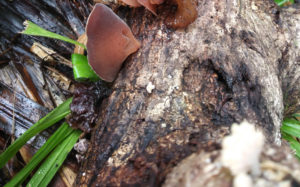As I look down where my red earth stained boots tread I see it! A rubbery, dark brown fungal growth emerging from the side of a twig no larger than the width of my index finger. I crouch down to the tree-shaded ground to have a closer look. Soft, velvety fuzz adorns the top of the emerging growth that looks nearly identical to the ear of a small, brown mammal. I pick up the twig and turn it slightly revealing the smooth underside of the mushroom. With a smile I glance towards the cloudy sky where I gaze upon the signature canopy leaves of the iconic tree whose nuts provided light to the people of this region for roughly a thousand years.
I close my eyes and extend my heart in all directions, connecting with all around me to share my intentions and to humbly request their permission for the harvest.
Five years earlier:
I raise a 16-pound iron digging stick straight up into the air, stab it down into the soil, and swirl it in a circle to create a conical cavity as Dr. Art Medeiros excitedly speaks of the interconnectedness of the species in this endangered forest he helped to revive. He carefully places a young native tree’s taproot into the narrow hole created by the digging stick and lovingly packs the soil back around it. I eagerly ask him about the cloud ear fungus I often see in forests during the cool, wet months and he excitedly talks about its important role in decomposition of fallen wood and how this species is a native mushroom to the Pacific islands.
Being native to the Pacific islands means that this fungus could have only arrived here by one of three ways: either by the winds, the wing of a bird, or by a wave. Did some mushroom spores get swept up and away in a storm system from a far away continent and amazingly land on fallen wood here? Did an exhausted golden plover, escaping the seasonal frigid cold of a temperate land, have touched down here with spores in its feathers? Could a mushroom – or its mycelium – have survived thousands of miles of open ocean waves on a log to land on these shores and upon maturity eject its spores here? I have seen cloud ear growing on a driftwood log sitting upon a windward beach. I think about all the cloud ear mushrooms I often see on fallen candlenut twigs and logs… could it have even first arrived here on a canoe centuries ago? All possibilities, I suppose.
Today, people are filled with the excitement of all that fungi offer to us and to the ecosystems upon which we have emerged, shape and rely on. Their excitement renews my passion for fungi as well as my passion for finding, propagating and caring for the native mushrooms here in these Pacific islands.